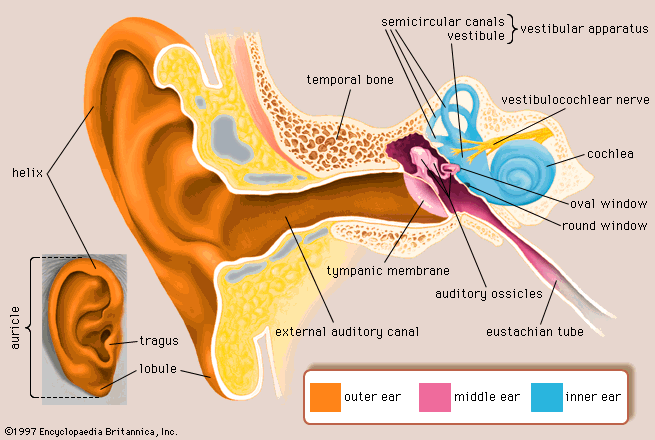Ear
Description of Niche
The Human Ear: The human ear is comprised of 3 main parts: outer, middle, and inner. The outer ear consists of the pinna, which is the visible part of the ear, and the auditory ear canal to the tympanic membrane(ear drum). The membrane separates the outer ear from the middle ear which is an air-filled space that is connected to the nasopharynx via the eustachian tube. The middle ear consists of the malleus, incus, and stapes. These three tiny bones carry sound from the ear drum to the inner ear. The inner ear (aka the bony labyrinth) is comprised of the cochlea and the vestibular apparatus.(1)
Physical Conditions?
The conditions of the pinna are similar to that of the skin(for more information please refer to the skin page). Closer to the ear canal the skin develops a thin lining of ear wax. Ear wax is composed mostly of dead skin cells and keratin with a small mixture of cerumen, sweat, and oil. Cerumen is secreted from the ceruminous glands located in the first third outer part of the ear canal and is thought to be composed mainly of cholesterol, squalene, wax esters, ceramides, and triglycerides. The cerumen also has antibacterial/fungal properties which can be attributed to its slight acidic pH of 6.1 and the presence of lysozyme. In normal individuals, the ear wax is continuously pushed out of the ear canal by the slow migration of the top layer of skin cells from the tympanic membrane towards the outer ear. The ear wax traps any foreign particles/organisms on its way out. The ear canal is a dark, moist, close to body temperature(~37C), and abundant with nutrients from dead skin cells.(2)(3) If not for the cerumen, the ear canal would be a very hospital place for microbes.
The middle ear, or tympanic cavity, is an air filled space that is connected to the outer ear via the tympanic membrane and the inner ear via the fenestra vestibuli. A mucous membrane lines the middle ear that is continuous with the nasal passageways and nasopharynx via the eustachian tube. The mucus serves to trap any particles and microbes that are inside and slowly move it towards the throat to be swallowed or coughed out. This migration of mucus is important to prevent microbes from colonizing as the tympanic cavity would otherwise present a very favorable environment for microbes. It is abundant in nutrients, moist, dark, protected from the external environment, and at body temperature.
The inner ear consists of two fluid-filled membraneous structures, the cochlea and the vestibular apparatus, surrounded by a hard bony shell. The two structures are adjacent to each other and share the fluid.
Conditions under which the environment changes
Do any of the physical conditions change? Are there chemicals, other organisms, nutrients, etc. that might change the community of your niche.
In regards to the ear, the environment of the outer ear is subject to the most variation. The one of the biggest effects on the environment of the ear would be those that remove the ear wax. This can occur through excessive showering or swimming as water/soap can wash away the thin protective lining of ear wax. Loss of the cerumen encourages the growth of microbes that are normally kept under control by its antimicrobial properties. Use of cotton swaps or hair pins is also common practice as a means to remove ear wax. In addition to the removal of the ear wax, they can also scratch the surface of the skin which can allow microbes to get in to the unprotected tissue. Use of cotton swabs also can push the ear wax further into the canal, which if allowed to build up can become impacted and damage the inner ear canal and the tympanic membrane. These too provide opportunities for microbes to infect the underlying tissue. Infections in the outer ear or damage to the tympanic membrane also provide venues for microbes to invade the middle and inner ear.
Who lives there?
Which microbes are present?
You may refer to organisms by genus or by genus and species, depending upon how detailed the your information might be. If there is already a microbewiki page describing that organism, make a link to it.
In the normal healthy ear, despite the best efforts of the ceruminous glands, the outer ear still houses a variety of microbes. The some of the most common bacteria are Staphylococcus epidermis, Turicellaotitidis, Alloiococousotitis, Pseudomonas aeruginosa, Corynebacterium, Staphylococcus aureus, and Streptococcus saprophyticum. The most common fungal microbe known to reside in the ear is Candida albicans. (7)(8)
Microbes that are known to inhabit the middle ear are Streptococci, Haemophilus pneumoniae, Moraxella catarrhalis, and less commonly mycobacterium.
Do the microbes that are present interact with each other?
Describe any negative (competition) or positive (symbiosis) behavior
Regarding the middle ear, research shows that alpha hemolytic streptococci from healthy children inhibit pneumococci and H. influenzae, two pathogens that cause Otitis media. (9)
Do the microbes change their environment?
Do they alter pH, attach to surfaces, secrete anything, etc. etc.
Do the microbes carry out any metabolism that affects their environment?
Do they ferment sugars to produce acid, break down large molecules, fix nitrogen, etc. etc.
Resources
1)
2)
3)^Bortz JT, Wertz PW, Downing DT. "Composition of cerumen lipids." J Am Acad Dermatol. 1990 Nov;23(5 Pt 1):845-9.
7)^Stroman DW, Roland PS, Dohar J, Burt W. "Microbiology of normal external auditory canal." Laryngoscope. 2001 Nov;111(11 Pt 1):2054-9
8)^Campos A, Arias A, Betancor L, Rodríguez C, Hernández AM, López Aguado D, Sierra A. "Study of common aerobic flora of human cerumen." J Laryngol Otol. 1998 Jul;112(7):613-6
9)^Tano K, Grahn-Håkansson E, Holm SE, Hellström S. "Inhibition of OM pathogens by alpha-hemolytic streptococci from healthy children, children with SOM and children with rAOM." Int J Pediatr Otorhinolaryngol. 2000 Dec 22;56(3):185-90.
http://www.meddean.luc.edu/depts/otolaryn/patient_ed/pdf/ENT%20INNER%20EAR%20FLUID%20IMBALANCE.pdf
http://jama.ama-assn.org/cgi/content/abstract/291/8/981 ( Outbreak of Pseudomonas aeruginosa Infections Caused by Piercing of Upper Ear Cartilage)

